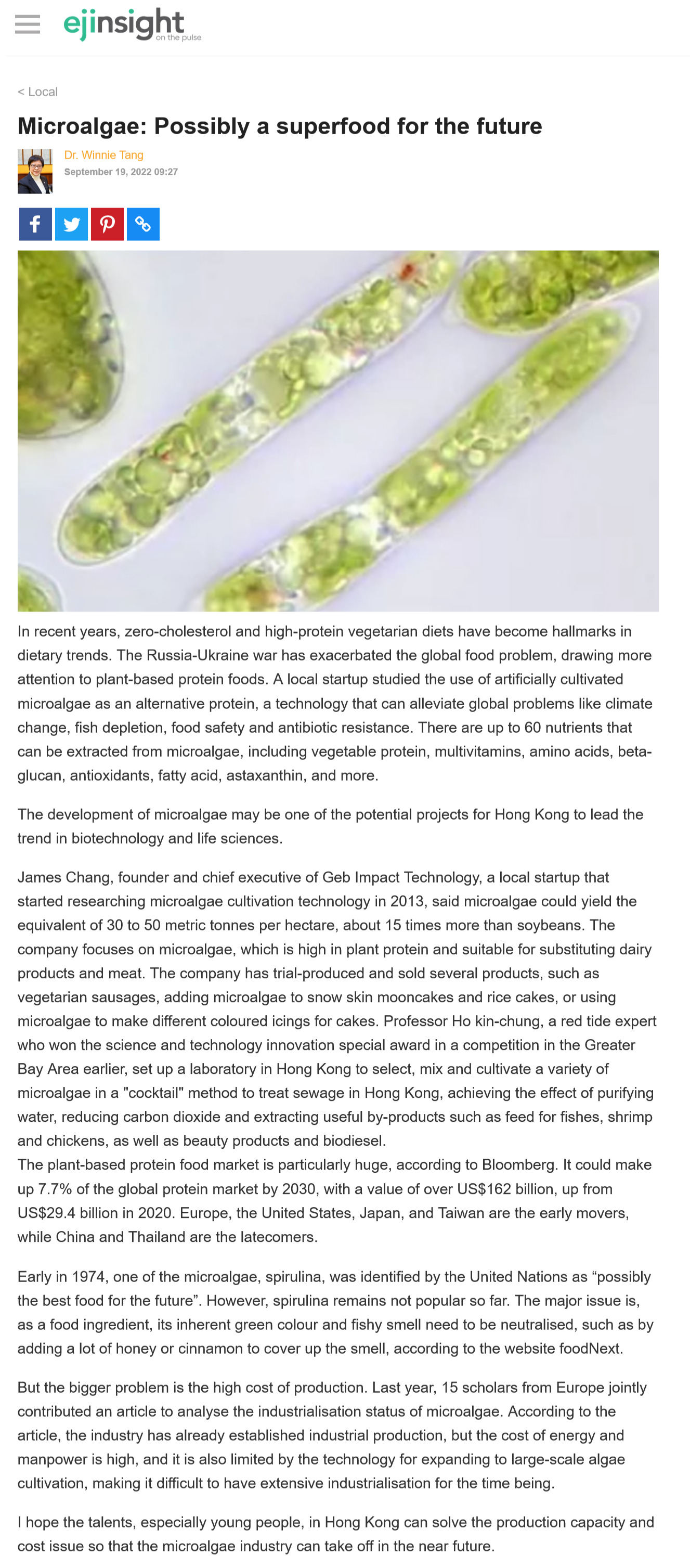網上版請按此

Microalgae: Possibly a superfood for the future
In recent years, zero-cholesterol and high-protein vegetarian diets have become hallmarks in dietary trends. The Russia-Ukraine war has exacerbated the global food problem, drawing more attention to plant-based protein foods. A local startup studied the use of artificially cultivated microalgae as an alternative protein, a technology that can alleviate global problems like climate change, fish depletion, food safety and antibiotic resistance. There are up to 60 nutrients that can be extracted from microalgae, including vegetable protein, multivitamins, amino acids, beta-glucan, antioxidants, fatty acid, astaxanthin, and more.
The development of microalgae may be one of the potential projects for Hong Kong to lead the trend in biotechnology and life sciences.
James Chang, founder and chief executive of Geb Impact Technology, a local startup that started researching microalgae cultivation technology in 2013, said microalgae could yield the equivalent of 30 to 50 metric tonnes per hectare, about 15 times more than soybeans. The company focuses on microalgae, which is high in plant protein and suitable for substituting dairy products and meat. The company has trial-produced and sold several products, such as vegetarian sausages, adding microalgae to snow skin mooncakes and rice cakes, or using microalgae to make different coloured icings for cakes. Professor Ho kin-chung, a red tide expert who won the science and technology innovation special award in a competition in the Greater Bay Area earlier, set up a laboratory in Hong Kong to select, mix and cultivate a variety of microalgae in a "cocktail" method to treat sewage in Hong Kong, achieving the effect of purifying water, reducing carbon dioxide and extracting useful by-products such as feed for fishes, shrimp and chickens, as well as beauty products and biodiesel.
The plant-based protein food market is particularly huge, according to Bloomberg. It could make up 7.7% of the global protein market by 2030, with a value of over US$162 billion, up from US$29.4 billion in 2020. Europe, the United States, Japan, and Taiwan are the early movers, while China and Thailand are the latecomers.
Early in 1974, one of the microalgae, spirulina, was identified by the United Nations as "possibly the best food for the future". However, spirulina remains not popular so far. The major issue is, as a food ingredient, its inherent green colour and fishy smell need to be neutralised, such as by adding a lot of honey or cinnamon to cover up the smell, according to the website foodNext.
But the bigger problem is the high cost of production. Last year, 15 scholars from Europe jointly contributed an article to analyse the industrialisation status of microalgae. According to the article, the industry has already established industrial production, but the cost of energy and manpower is high, and it is also limited by the technology for expanding to large-scale algae cultivation, making it difficult to have extensive industrialisation for the time being.
I hope the talents, especially young people, in Hong Kong can solve the production capacity and cost issue so that the microalgae industry can take off in the near future.
Dr. Winnie Tang
Adjunct Professor, Department of Computer Science, Faculty of Engineering; Department of Geography, Faculty of Social Sciences; and Faculty of Architecture, The University of Hong Kong